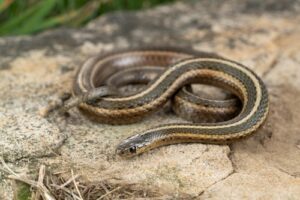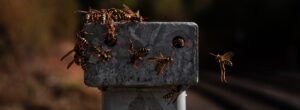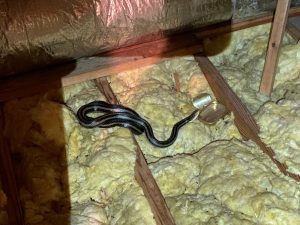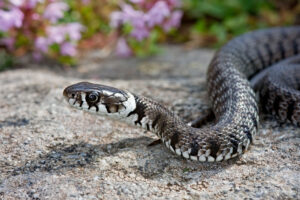Snake in House
Snakes in the house typically enter either by accident or in search of food and shelter. Either way, most snakes tend to come in at the ground floor of a structure. The reptiles find entrances via gaps under doors or openings in the walls and foundations, around plumbing and vents, and even through pet doors.
Snakes prefer to hide in well-covered areas outside, including firewood piles, leaf litter, tall grasses, and rock walls. If such areas are near the structure, snakes can easily gain access to the home.
Homeowners may find snakes in various areas of the home, but most are found in basements, crawl spaces, dirt cellars, and garages. Certain tree dwelling snakes can enter into attics through holes in the roof, as well.

WHY IS A SNAKE IN THE HOUSE?
Snakes in the house find their way inside by following food sources such as mice and rats. Once snakes realize that there is an easy food source, they will move in. Finding shed skins usually points to snakes taking up long-term residence. Other times, snakes enter the home by mistake and are generally searching for a way out when homeowners encounter them.
Customer FAQ:
I am interested in taking measures to “snake-proof” my yard and home.
– Fort Worth, TX
Technician Answer:
For snake issues, we focus on removing the problem snake. More importantly, we figure out why that snake was attracted to the home. Usually, there is some food source drawing it in. Once the initial problem is resolved, we then focus on preventing other snakes from coming into the area.
In addition to sealing areas into the home, we use deterrents as well as food source reduction to help prevent future snake issues. We also offer snake removal with the preventative service, so If an issue arises, we can come out and resolve it!
Our initial service can take anywhere from a day to a few weeks, depending on how bad the problem is. The preventative services would be set up so that we would come out on a regular basis, usually every 30 days, and you would want to keep this for as long as you wanted snake control around the home.

HOW DO SNAKES GET INTO WALLS?
Snakes are nimble creatures able to squeeze into tight crevices and small spaces. They can find their way into buildings and walls through cracks and gaps in siding, windows, screens, brick, and wood foundations. The legless pests also gain access to homes and walls through drainage systems.
HOW SNAKES END UP IN THE BATHROOM?
Snakes typically enter homes in search of food or shelter from the elements. Bathrooms, specifically the spaces around toilets and drains, are ideal hiding places thanks to their high moisture levels and relative darkness. Snakes gain access to these areas via the gaps around pipes where they enter buildings, or by swimming through plumbing into toilets.
Since some home-invading species are venomous, having snakes in toilets and bathrooms is dangerous, especially when house residents are unaware of their presence. Even non-venomous snakes pose threats, as they will lash out and bite if they feel cornered or threatened.

HOW DO SNAKES GET INTO THE BASEMENT?
Snakes are long, cylindrical, and legless, which means they are not typically skilled climbers. When the pests invade homes, they must enter though openings found in the building’s foundation. This may include cracks in the bedrock, slits under doorways, pet flaps, tunnels that lead under structures, and warped siding. Once inside, snakes search for secluded locations with plenty of food and often end up in basements or crawlspaces.
WHAT MAKES BASEMENTS SO ATTRACTIVE?
When snakes enter homes intentionally, they are usually following prey or looking for suitable locations for hibernation. In the wild, the pests frequently rest in the spaces under rocks, and basements provide a similar environment. They offer consistent temperatures, moisture, darkness, relative quiet, and minimal activity, which makes them perfect for overwintering.
Property owners may also find snakes in the basement when rodent or insect infestations are present. Though different species of snakes prefer different food sources, rats, mice, and various types of insects are common prey. These pests are all commonly found in basements when they infest homes, thus making the basement attractive to hungry snakes.

HOW DO SNAKES GET INTO ATTICS?
Since they don’t have arms or legs, snakes are not typically able to climb and therefore tend to infest homes at the ground level. However, certain species, including brown tree snakes, rat snakes, and various types of pythons, are agile climbers. They can easily scale trees and enter homes via chimneys, vents, open windows, and gaps in exterior siding. Once inside, they like to congregate in spaces that see very little human activity, such as wall cavities and attics.
WHAT MAKES ATTICS ATTRACTIVE TO SNAKES?
Attics are popular denning sites for snakes because they are often home to infestations of rodents and offer seclusion from human residents. Rats, mice, and squirrels are all prime sources of food for snakes, and when property owners find snakes in the attic, they almost certainly have a rodent infestation, as well. The upper floors of homes are also consistently warm and provide plenty of cover, so snakes are able to regulate their body temperature and stay hidden.

HOW DO SNAKES GET INTO CRAWL SPACES?
Snakes typically enter homes at the ground level. Cracks in building foundations or walls larger than 1/4 of an inch in diameter are wide enough for most species of home-invading snakes to slither through and are the most common point of entrance for the pests. Vents, pipes, the spaces under doors, and gaps around utility and plumbing lines also make suitable entrances. Dark, damp locations make perfect overwintering sites for snakes, who often hole up in crawl spaces when temperatures begin to drop. In the spring and summer, the pests tend to congregate in these areas looking for food like various species of rodents and insects. If snakes feel safe and have consistent access to food, they may decide to lay eggs. Residents may find multiple snakes in the crawl space, as a few species nest together.
WHAT ATTRACTS SNAKES TO GARAGES?
Snakes are natural predators that hunt insects and small rodents. When unsecured containers of pet food or bird seed in the garage attract mice and cockroaches, it can create an ideal hunting ground for snakes. On hot, sunny days, snakes may also be attracted to the cool shade of an open garage, where they can take up residence beneath piles of junk, debris, or lumber.
Snakes in garages usually get there by slithering through an open door or a crack in the wall. However, they are also very good climbers and can enter through unsecured windows, loose roof tiles, or vents. Small opening around pipes, loose boards, and improperly sealed garage doors are all potential entry points.
WHY SNAKES ENTER YARDS
Snakes enjoy locations that offer both ample cover from predators and plenty of food. Potential food sources range from rodents and other small mammals, to reptiles and amphibians as well as insects. Many yards contain at least some form of snake food and often provide enough cover for use as shelter.
Yards harboring an abundance of food sources and sheltered locations attract high numbers of snakes and increase the potential for human encounters with the reptiles. Snakes in the grass or yard act as a form of natural pest control, but can also create undesirable outcomes.

ROBLEMS CAUSED BY SNAKES IN GRASS
People who live within the range of venomous snakes should take the pests seriously and proceed with caution in suspected habitats. Once snakes are in the yard, they can easily enter buildings, where uncomfortable encounters are likely to arise and the potential for bites increases. Snake bites are painful even when the snake lacks venom. It may be due to the possibility of a bite that creates fear of the animals. Both pets and children in snake-ridden areas are at high risk of encountering a snake in the grass, as they traditionally frequent and play in yards.
PREVENT & REMOVE SNAKES IN HOUSE
It takes a combination of different actions to keep snakes from entering the house. Exclusion, habitat modification, and eliminating potential food sources should all be used together to ensure that snakes do not get into homes.
Depending on the region of the country, homeowners may face both venomous and non-venomous snake incursions. Any cornered snake can strike whether venomous or not, making it highly advisable to contact the trained professionals at Trutech to eliminate and remove snakes in the house.
Customer FAQ
I’d like to find out about snake prevention for my yard.
–Atlanta, GA
Answer:
Trutech can provide snake control at your property. Our first step is a visit to your home, at which point we will conduct a full inspection of your property and your home. Inspecting the inside of your home is just as important as the outside because snake activity is driven by one thing: a food source. If you have a rodent or pest control issue inside or around your home, in all likelihood, that is the reason you are seeing snakes. Inspections of both your crawlspace and attic space are vital in order to determine the snakes’ food source. During the course of our inspection, if we find any snakes, we will remove them if possible.
Following the inspection, we will recommend a snake control program based on our findings. The best way to control snake activity is to reduce their food sources. We can accomplish this by conducting a regularly scheduled pest control service in order to reduce insect activity in and around your home. If there is an underlying rodent issue, we will trap and bait to reduce that population. A snake deterrent, as well as snake traps, can also be applied and placed around your yard.
Customer FAQ
I have been seeing more garter snakes and it’s causing me anxiety about maintaining and using the yard. Is there any way to be rid of them and keep them from returning?
–Greenville, SC
Expert Answer:
Thank you for your question. Garter snakes follow pheromone trails of other garter snakes to find den locations and a mate. This can attract hundreds of snakes to a single area. To help control this pest, Trutech uses several methods of control such as repellants and food source reduction. As a homeowner, you also can help with the process by modifying the property landscaping. Keeping leaf litter picked up, keeping the lawn mowed, or reducing ground cover like Juniper bushes minimizes the areas the snakes have to harbor. Complete control does take time to achieve and Trutech will establish a comprehensive service to keep the snakes from becoming out of control.

How to Identify Snake Holes in North Carolina and What to Do About Them
Discovering holes in your yard can be unnerving, as it is often difficult to tell what created it, and if it is still occupied or

The Most Common Summertime Pests & Critters
Summer is the season of pests. Bugs seem to cloud our vision; nighttime is marked by a chorus of chittering insects; bites materialize suddenly on

Snake Holes in Florida
Discovering holes in your yard can be unnerving, as it is often difficult to tell what created it, and if it is still occupied or

Are These Snake Holes in My Texas Yard?
Discovering holes in your yard can be unnerving, as it is often difficult to tell what created it, and if it is still occupied or

Can Snakes Climb? Finding Snake Skins in Attic
In Greenville, a homeowner heard the strangest sound in their attic. After an investigation, we found a snake skin in the attic! In South Carolina,

How to Get Rid of Snakes
For most people, finding a snake in your house or in your yard can be alarming. But the fact is, most snakes are harmless to


